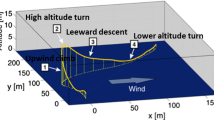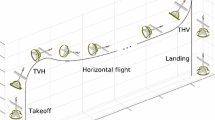Abstract
Unmanned Aerial Gliders form a subclass of fixed-wing Unmanned Aerial Vehicles which promise to offer sustained flight for a wide range of applications. Autonomous soaring allows these aircraft to detect and exploit rising air masses (thermals) without user input, which greatly simplifies their operation. While previous research has focused on the detection and exploitation of thermal updraft, the initial turn at the entry point into the thermal has been ignored. This paper explores the initial turn decision at the instant of thermal detection in order to improve soaring performance by flying directly into the thermal. A high-fidelity simulation of an off-the-shelf RC glider is constructed, along with the Weather Research and Forecasting model to capture realistic thermal convection. The effects of turn decisions on thermalling performance are examined through a large batch simulation on a Matlab/Simulink environment. Thermalling algorithms are subsequently integrated into the PX4 flight stack for Software-in-the-Loop simulations and flight tests using a Pixhawk flight controller. Simulated and experimental results demonstrate the importance of turn decisions for improved overall soaring performance.
Similar content being viewed by others
Explore related subjects
Discover the latest articles, news and stories from top researchers in related subjects.References
Allen, M.J.: Updraft model for development of autonomous soaring uninhabited air vehicles. In: 44th AIAA Aerospace Sciences Meeting and Exhibit (2006). https://doi.org/10.2514/6.2006-1510
Allen, M.J., Lin, V.: Guidance and control of an autonomous soaring UAV. Tech. rep, NASA Dryden Flight Research Center (2007)
Anderson, J.D.: Aircraft Performance and Design. McGraw-Hill Education, New York (1998)
Beard, R.W.: Small Unmanned Aircraft - Theory and Practice. Princeton UP, NJ (2012)
Bencatel, R., Borges de Sousa, J., Renee Girard, A.: Atmospheric flow field models applicable for aircraft endurance extension. In: Progress in Aerospace Sciences, pp 61:1–25 (2013)
Daugherty, S.C., Langelaan, J.W.: Improving autonomous soaring via energy state estimation and extremum seeking control. In: AIAA Guidance, Navigation, and Control (2014)
Depenbusch, N.T., Bird, J.J., Langelaan, J.W.: The AutoSOAR autonomous soaring aircraft, part 1: Autonomy algorithms. Journal of Field Robotics 35(6), 868–889 (2018)
Depenbusch, N.T., Bird, J.J., Langelaan, J.W.: The AutoSOAR autonomous soaring aircraft part 2. Journal of Field Robotics 35(4), 435–458 (2018)
Edwards, D.: Performance testing of RNR’s SBXC using a piccolo autopilot (2007)
Edwards, D.J.: Implementation details and flight test results of an autonomous soaring controller. In: AIAA Guidance, Navigation and Control Conference and Exhibit (2008)
Edwards, D.J.: Autonomous locator of thermals (ALOFT) autonomous soaring algorithm. Tech. rep, Naval Research Laboratory (2015)
Edwards, D.J., Kahn, A.D., Kelly, M., Heinzen, S., Scheiman, D.A., Jenkins, P.P., Walters, R., Hoheisel, R.: Maximizing net power in circular turns for solar and autonomous soaring aircraft. Journal of Aircraft 53(5), 1237–1247 (2016)
El Tin, F., Borowczyk, A., Sharf, I., Nahon, M.: Turn decision-making for improved autonomous thermalling of unmanned aerial gliders. In: International Conference on Unmanned Aircraft Systems, pp. 1368–1375. IEEE (2020)
Gao, C.: Autonomous soaring and surveillance in wind fields with an unmanned aerial vehicle. Ph.D. thesis, University of Toronto (2015)
Giordano, C., Vernin, J., Vazquez Ramio, H., Munoz-Tunon, C., Varela, A.M., Trinquet, H.: Atmospheric and seeing forecast: WRF model validation with in situ measurements at ORM. Monthly Notices of the Royal Astronomical Society 430(4), 3102–3111 (2013). https://doi.org/10.1093/MNRAS/STT117
Hazard, M.: Unscented kalman filtering for real-time atmospheric thermal tracking. Ph.D. thesis, North Carolina State University, Raleigh, North Carolina (2010)
Irving, F.: The Paths of Soaring Flight. Imperial College Press, London (1999)
Lawrance, N.R.J., Sukkarieh, S.: Wind energy based path planning for a small gliding unmanned aerial vehicle. In: AIAA Guidance, Navigation, and Control Conference (2009)
Lawrance, N.R.J., Sukkarieh, S.: Autonomous exploration of a wind field with a gliding aircraft. AIAA J. Guid. Control Dyn. 34(3) (2011). https://doi.org/10.2514/1.52236
Moeng, C.H., Dudhia, J., Klemp, J., Sullivan, P.: Examining two-way grid nesting for large eddy simulation of the PBL using the WRF model. Monthly Weather Review 135(6), 2295–2311 (2007). https://doi.org/10.1175/MWR3406.1
Moorhouse, D.: Flying qualities of piloted airplanes. Tech. rep., U.S. Department of Defense (1982)
Pennelly, C., Reuter, G.: Verification of the weather research and forecasting model when forecasting daily surface conditions in Southern Alberta. Atmosphere-Ocean 55(1), 31–41 (2017). https://doi.org/10.1080/07055900.2017.1282345
Phillips, W.: Mechanics of Flight. Wiley, New York (2009)
Reichmann, H.: Cross Country Soaring. Thomson Publications, Santa Monica, CA (1978)
Skamarock, W., Klemp, J., Dudhia, J., Gill, D., Zhiquan, L., Berner, J., Wang, W., Powers, J., Duda, M.G., Barker, D.M., Huang, X.Y.: A description of the advanced research WRF model version 4. Tech. rep., NCAR (2019). https://doi.org/10.5065/1dfh-6p97
Stolle, M., Watanabe, Y., Doll, C., Bolting, J.: Vision-based lifespan and strength estimation of sub-cumulus thermal updrafts for autonomous soaring. In: International Conference on Unmanned Aircraft Systems (ICUAS), pp. 162–169 (2016)
Tabor, S., Guilliard, I., Kolobov, A.: ArduSoar: an open-source thermalling controller for resource-constrained autopilots. In: International Conference on Intelligent Robots and Systems (IROS), pp. 6255–6262. IEEE (2018)
Wharington, J.: Autonomous control of soaring aircraft by reinforcement learning. Ph.D. thesis, Royal Melbourne Institute of Technology (1998)
Williams, J.E., Vukelich, S.R.: The USAF Stability and Control Digital DATCOM, vol. 1. Tech. rep, USAF (1979)
Acknowledgements
The authors would like to thank Jacques Girard for his help with piloting the vehicle and his advice on thermal soaring with RC gliders.
Funding
This work was supported by the National Sciences and Engineering Research Council (NSERC) Canadian Robotics Network (NCRN), the McGill Engineering Doctoral Awards (MEDA), the Fonds de Recherche du Québec Nature et Technologies (FRQNT), and a Mitacs Accelerate grant.
Author information
Authors and Affiliations
Corresponding author
Ethics declarations
Conflicts of interest
The authors declare that they have no conflict of interest.
Additional information
Publisher’s Note
Springer Nature remains neutral with regard to jurisdictional claims in published maps and institutional affiliations.
A version of the submitted paper appeared in the Proceedings of the 2020 International Conference on Unmanned Aircraft Systems (ICUAS’20), Athens, Greece.
Appendix
Appendix
Rights and permissions
About this article
Cite this article
Tin, F.E., Borowczyk, A., Sharf, I. et al. Turn Decisions for Autonomous Thermalling of Unmanned Aerial Gliders. J Intell Robot Syst 104, 25 (2022). https://doi.org/10.1007/s10846-021-01547-3
Received:
Accepted:
Published:
DOI: https://doi.org/10.1007/s10846-021-01547-3




